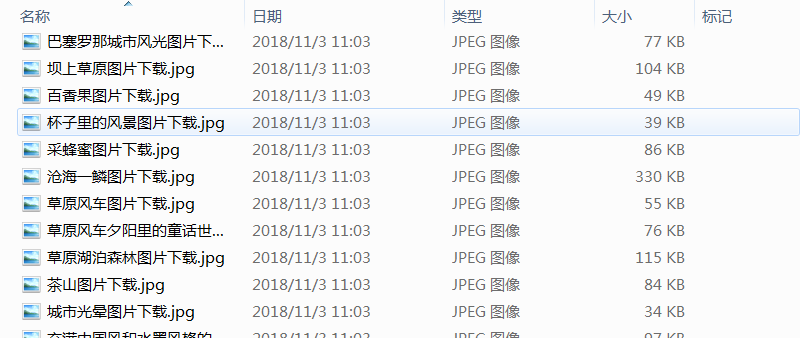
''' 时间:2018/11/03 功能:bs4解析html 目录: 一: 学习使用 1 官网介绍 2 安装Beautiful Soup 3 四种对象 (1) 全部 (2) 标签 (3) 字符 (4) 注释 二: 实战使用 '''
一: 学习使用
1 官网介绍

1 : 访问官网地址: https://beautifulsoup.readthedocs.io
2 : 可以查看介绍和使用。
2 安装Beautiful Soup
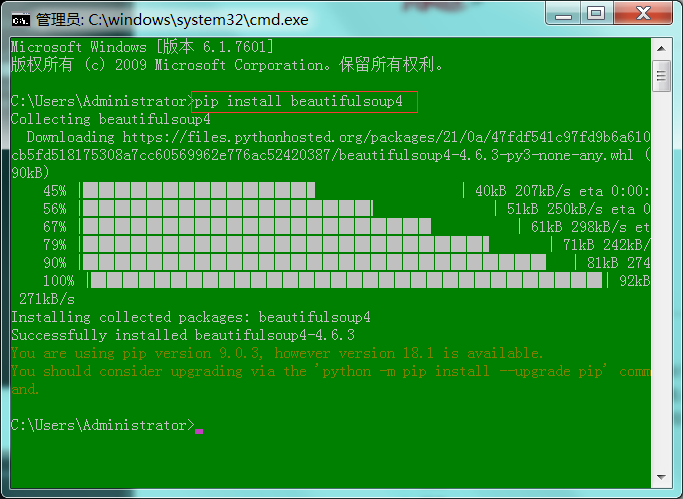
1 : 运行输入"cmd",进入Dos窗口。
2 : 输入"pip install beautifulsoup4"(安装beautifulsoup4模块)。
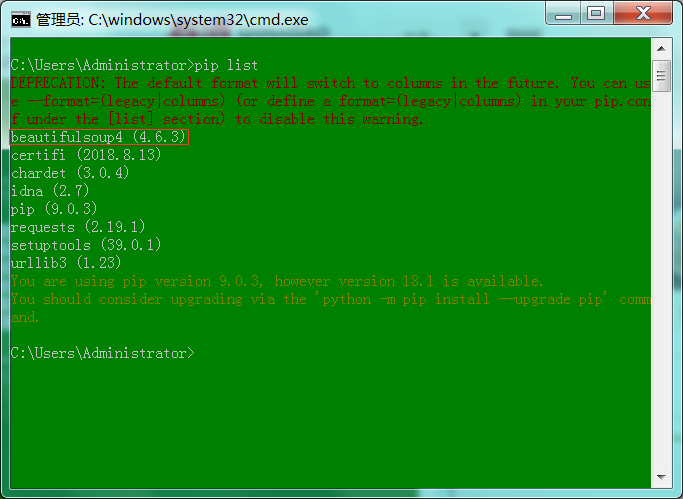
1 : 输入"pip list"(查看安装的库)。
2 : 可以看见已经安装了beautifulsoup4 (4.6.3)。
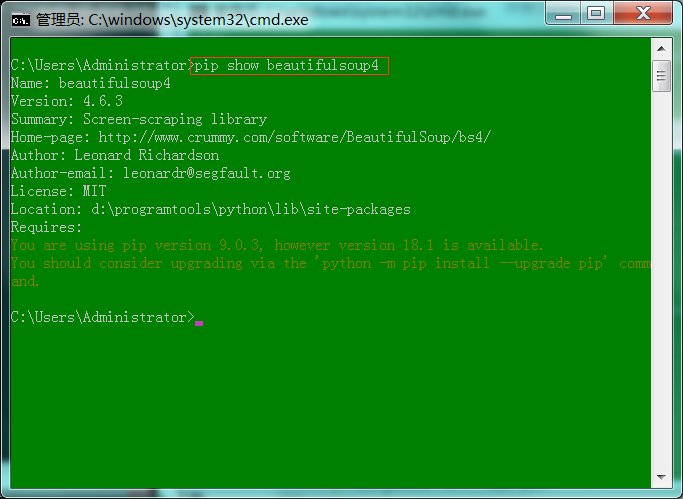
1 : 输入"pip show beautifulsoup4"(查看beautifulsoup4的信息)。
3 四种对象
(1) 全部
<meta charset="UTF -8"> <! -- for HTML5 -- > <meta http-equiv="Content-Type" content="text/html; charset=utf -8"/> <html> <head><title>汁虫</title></head> <body> <b><! -- Hey, this in comment!--></b > <p class="title"><b>汁虫</b></p> <a href="https://www.cnblogs.com/huafan/category/1264131.html" class="sister" id="link1">fiddler</a>, <a href="https://www.cnblogs.com/huafan/category/1282855.html" class="sister" id="link2" >python</a>, <a href="https://www.cnblogs.com/huafan/category/1264133.html" class="sister" id="link3" >python</a>, 快来关注吧!</p> <p class="story">...</p>
1 : 使用这份html做测试文档,命名为"汁虫.html"。
# coding:utf-8 from bs4 import BeautifulSoup # 打开文件 yo = open("汁虫.html", # 文件路径 - 同一级目录不需要写路径 "rb") # 打开方式 - 读取 # 全部显示 - html soup = BeautifulSoup(yo, # 文件的对象 "html.parser") # 解析器名称 print(soup, end=" ") # 打印内容 print(type(soup)) # 打印类型
<meta charset="utf-8"/> <!-- -- for HTML5 -- --> <meta content="text/html; charset=utf-8" http-equiv="Content-Type"> <html> <head><title>汁虫</title></head> <body> <b><!-- -- Hey, this in comment!----></b> <p class="title"><b>汁虫</b></p> <a class="sister" href="https://www.cnblogs.com/huafan/category/1264131.html" id="link1">fiddler</a>, <a class="sister" href="https://www.cnblogs.com/huafan/category/1282855.html" id="link2">python</a>, <a class="sister" href="https://www.cnblogs.com/huafan/category/1264133.html" id="link3">python</a>, 快来关注吧!</body></html></meta> <p class="story">...</p> <class 'bs4.BeautifulSoup'>
1 : 打印全部html内容。
(2) 标签
# coding:utf-8 from bs4 import BeautifulSoup # 打开文件 yo = open("汁虫.html", # 文件路径 - 同一级目录不需要写路径 "rb") # 打开方式 - 读取 soup = BeautifulSoup(yo, # 文件的对象 "html.parser") # 解析器名称 # 获取标签 print(soup.title) # 获取标签 print(soup.p.b) # 多层标签 print(soup.a) # 获取标签: 相同名称 - 获取第一个
<title>汁虫</title> <b>汁虫</b> <a href="https://www.cnblogs.com/huafan/category/1264131.html class=" id="link1" sister"="">fiddler</a>
1 : 打印全部html中标签内容。
# coding:utf-8 from bs4 import BeautifulSoup # 打开文件 yo = open("汁虫.html", # 文件路径 - 同一级目录不需要写路径 "rb") # 打开方式 - 读取 soup = BeautifulSoup(yo, # 文件的对象 "html.parser") # 解析器名称 # 获取标签 - 属性 att = soup.a.attrs # 标签属性 : 数据转换 - 字典类型 print(att) print(att['href']) print(att['class'][0]) print(att['id'])
{'href': 'https://www.cnblogs.com/huafan/category/1264131.html', 'class': ['sister'], 'id': 'link1'}
https://www.cnblogs.com/huafan/category/1264131.html
sister
link1
1 : 打印全部html中标签的属性。
# coding:utf-8 from bs4 import BeautifulSoup # 打开文件 yo = open("汁虫.html", # 文件路径 - 同一级目录不需要写路径 "rb") # 打开方式 - 读取 soup = BeautifulSoup(yo, # 文件的对象 "html.parser") # 解析器名称 # 打印标签 - 相同标签 all = soup.find_all('a') # 获取list对象 for nLoop in all: print(nLoop) # 打印输出 - 具体标签 print("") # 换行输出 print(all[1]) # 获取标签 - 第二个 att = all[1].attrs # 获取标签属性 print(att)
<a class="sister" href="https://www.cnblogs.com/huafan/category/1264131.html" id="link1">fiddler</a> <a class="sister" href="https://www.cnblogs.com/huafan/category/1282855.html" id="link2">python</a> <a class="sister" href="https://www.cnblogs.com/huafan/category/1264133.html" id="link3">python</a> <a class="sister" href="https://www.cnblogs.com/huafan/category/1282855.html" id="link2">python</a> {'href': 'https://www.cnblogs.com/huafan/category/1282855.html', 'class': ['sister'], 'id': 'link2'}
1 : 打印相同的标签。
(3) 字符
# coding:utf-8 from bs4 import BeautifulSoup # 打开文件 yo = open("汁虫.html", # 文件路径 - 同一级目录不需要写路径 "rb") # 打开方式 - 读取 soup = BeautifulSoup(yo, # 文件的对象 "html.parser") # 解析器名称 # 获取标签 - 字符串 print(soup.a.string)
fiddler
1 : 打印标签中的字符串。
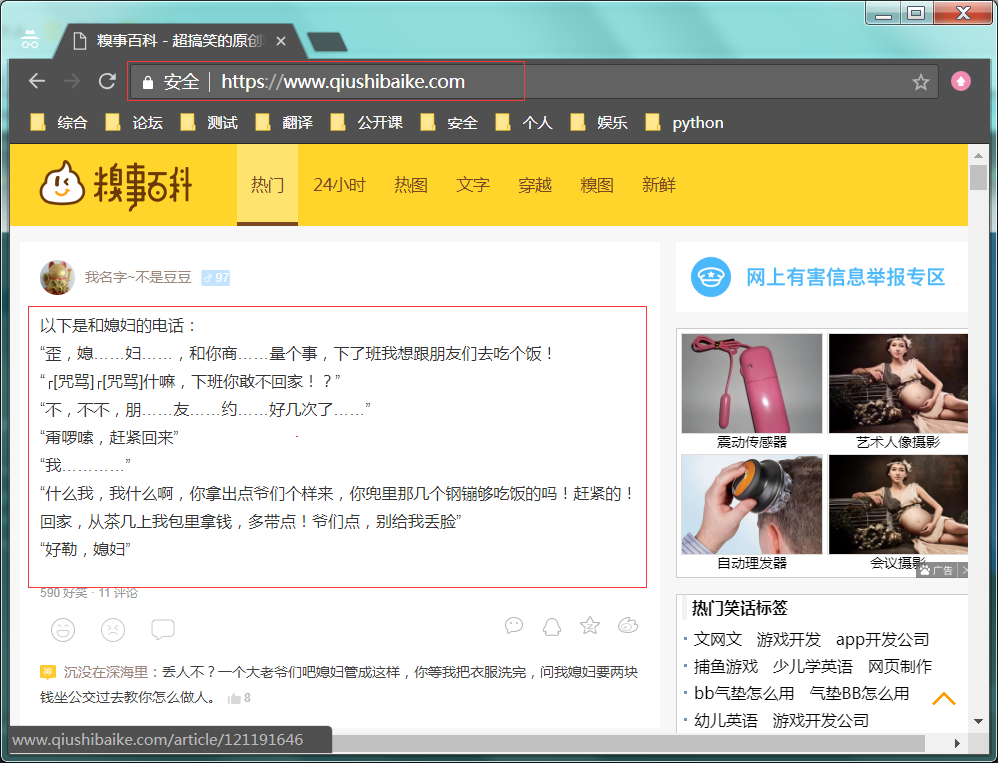
1 : 获取目标网址中红框内容。
# coding:utf-8 import requests import urllib3 urllib3.disable_warnings() # 忽略警告 from bs4 import BeautifulSoup url = "https://www.qiushibaike.com/" head = { "User-Agent" : "Fiddler" } r1 = requests.get(url, headers=head, verify = False) soup = BeautifulSoup(r1.content, "html.parser") all = soup.find_all(class_="content") # 命名冲突 : html的class - python的class for i in all: print(i.span.get_text().replace(" ", "")) # get_text() : 获取标签下 - 所有文本

(4) 注释
(暂无)
二: 实战使用
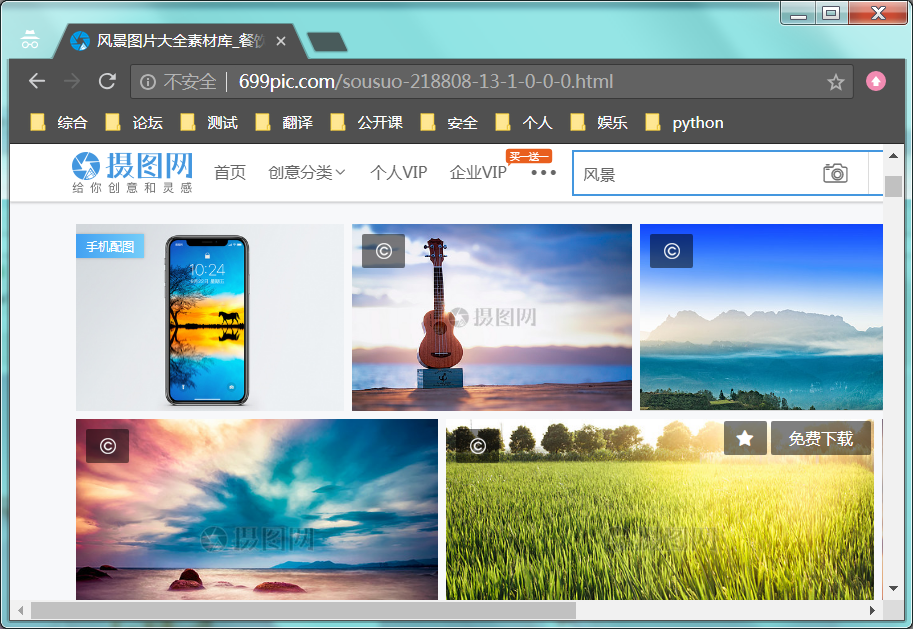
1 : 下载目标网址: http://699pic.com/sousuo-218808-13-1-0-0-0.html 的图片。
# coding:utf-8 import requests from bs4 import BeautifulSoup url = "http://699pic.com/sousuo-218808-13-1-0-0-0.html" r1 = requests.get(url, verify = False) soup = BeautifulSoup(r1.content, "html.parser") all = soup.find_all(class_ = "lazy") # 获取标签 - 所有标签 for i in all: # 异常情况处理 try: jpg_url = i["data-original"] # 获取地址 - 图片下载 print(jpg_url, end="") # 打印地址 jpg_title = i["title"] # 获取名称 - 图片命名 print(jpg_title) # 打印名称 r2 = requests.get(jpg_url) # 请求下载 with open(jpg_title + ".jpg", "wb") as fp: # 文件写入 fp.write(r2.content) # 写入图片 except: pass

